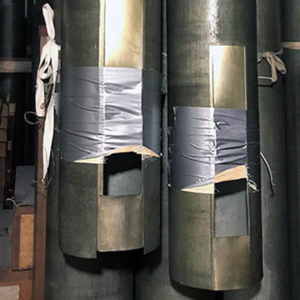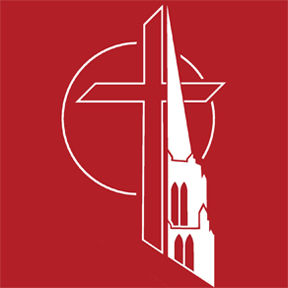
A Sanctuary of Sound
in the Heart of the City
Opus 414 FAQs
Below are some of the most frequently asked questions (FAQs) about Opus 414 and the restoration project. Answers will be updated and new questions added, as appropriate.
Opus 414 (formally E.M. Skinner, Opus 414) is the name of the pipe organ located in the first-floor sanctuary of First United Methodist Church in the Chicago Temple building.
Like most pipe organs, Opus 414 was named for its builder (E.M. Skinner) and given an Opus number (414) that identifies its place in the chronology of the organs built by Skinner.
Skinner had built 413 pipe organs—and was the most sought-after organ builder in the USA in the first quarter of the twentieth century—before designing one for the Chicago Temple.
 When originally installed, Opus 414 had 4,316 pipes.
When originally installed, Opus 414 had 4,316 pipes.
In the 1980s, the organ was seriously damaged by water from a leaking sink. When it was repaired, the church elected to expand the organ to 5,589 pipes, still controlled via four keyboards.
For details, see the Opus 414 stoplist page.
Opus 414 operates like most modern pipe organs. A player (the organist) controls the instrument through the console that can be seen on the right side of the first-floor sanctuary.
This console consists of four keyboards, a pedal board, and more than five thousand pipes under high wind pressure that speak from behind the extensive grill-work above the chancel area. When played, each pipe produces a single pitch and a unique tone.
Pipe organ sounds can last an unlimited time, as long as the notes on the console are held, while maintaining pitch, timbre and volume. Instruments like pianos and harpsichords have a relatively rapid decay of their sounds, once the notes are played.
 Opus 414 is nearing one hundred years of service, and in addition to the deterioration that would be expected after a century of continuous use, it suffers from recurring mechanical problems that have been increasing in number and severity for almost two decades.
Opus 414 is nearing one hundred years of service, and in addition to the deterioration that would be expected after a century of continuous use, it suffers from recurring mechanical problems that have been increasing in number and severity for almost two decades.
These problems include:
- The performance of the organ is unpredictable, with wide variations in the quality and accuracy of its sound
- Some notes do not play
- Some notes play spontaneously when they should not
- Leaks in the wind system make it difficult to keep the organ in tune
- Leaks in the wind system cause imbalances from one division of the organ to the next
- The newer electronic control system of the console does not connect effectively with the older electronic mechanisms in the organ chamber
- The echo division of the organ is no longer functional
- The mechanical integrity of the organ has been severely damaged by leaking water on three separate occasions including as recently as 2012
Those who play the organ are able to compensate for many of these problems because the organ is large and not all parts of every division are needed in order to play for worship services.
However, new problems arise every month and soon it will be impossible for organists to disguise the fact that the organ is aging rapidly and urgently needs attention.
The Committee for the Restoration of Opus 414 considered replacing the aging organ.
After consulting with several experts, the unanimous opinion was that, from the sole perspective of finances, it would cost 80-90 percent more to replace the organ than it would cost to repair it.
From the perspective of artistic merit, most of the original pipes and sounds that are part of the present organ are unique, irreplaceable and could not be easily replicated.
From a historical and aesthetic perspective, the organ was an original element of the building, was built for and alongside it, and has served the church and the community since 1924.
All components of Opus 414 will be removed from the organ chamber located at the front of the church’s first-floor sanctuary (above the chancel area).
The components will be completely rebuilt and refreshed at the Schantz Organ Company in Orville, Ohio. Those components that are too worn out to be reused will be replaced with new parts. This process is expected to take 14-16 months.
While the organ is being rebuilt in Ohio, the church’s organ chamber will be repainted, rewired, relighted, re-plastered and otherwise prepared for reinstallation of Opus 414.
 All of the previous repairs and modifications made to Opus 414 have been done in stages. Portions of the organ were worked on while others were left in place.
All of the previous repairs and modifications made to Opus 414 have been done in stages. Portions of the organ were worked on while others were left in place.
This piecemeal approach resulted in a complex system of original, patched, repaired and replaced parts struggling to work together. All of the elements were installed by different vendors at different times and they are all aging on different timelines. Some repairs, particularly those in the 1980s, were made with experimental materials and techniques that have not stood the test of time.
The end result is that conflicts and incompatibility within the organ itself have become a major problem, and adding another round of piecemeal repairs threatens to make the situation worse while not solving the fundamental issues facing the instrument.
Finally, there are parts of the organ in dire need of restoration that can only be accessed by removing them through the front grill over the chancel area. This process will be so complex, expensive and disruptive to weekly worship activities that it truly is considered a once-in-a-century project.
For these reasons, The Committee for the Restoration of Opus 414 decided that it would be most cost-effective and least disruptive to restore the entire organ at one time in one cohesive project.
Although regular maintenance will be necessary each year to keep the organ in proper working condition, it is expected that project like this one will not be necessary for another one hundred years.
An electronic organ will be rented while Opus 414 is out of commission.
The Committee for the Restoration of Opus 414 requested bids from three highly successful organ builders, each with deep experience in rebuilding large, early twentieth-century organs. Each builder sent two or more people to examine all aspects of the organ for an entire day.
After receiving detailed written proposals from each company, the Committee conducted interviews with representatives from each company. These interviews were two hours in length and allowed the committee to ask further questions and fill out their impressions about each builder and their proposals.
The Committee unanimously recommends awarding the contract to the Schantz Organ Company on the basis of their superior artistic and practical vision for our project.
 Schantz Organ Company was founded in 1873 by A.J. Tschantz, (later changed to Schantz) and is the oldest and largest American pipe organ builder still under management of its founding family.
Schantz Organ Company was founded in 1873 by A.J. Tschantz, (later changed to Schantz) and is the oldest and largest American pipe organ builder still under management of its founding family.
In the early part of the twentieth century, A.J.'s sons joined him in his organ building shop, and under their leadership the growing company developed a strong reputation.
Today, Schantz is widely considered to be America’s premier builder of electro-pneumatic pipe organs. Work continues under the management of the fourth generation of the Schantz family.
Commissions for the firm include projects ranging in size from new and replacement consoles, to small organs of a few ranks, to complex designs for some of the world’s largest concert halls, churches and cathedrals. Their work restoring the E. M. Skinner organs at Severance Hall in Cleveland and at Rockefeller Chapel at the University of Chicago are particularly notable.
More information can be found on the Schantz Organ Company website.
The Committee for the Restoration of Opus 414 is the process of developing fundraising goals that will cover not only restoration of the organ, but also endowments to support its ongoing maintenance and for an organ concert series.
When these goals have been determined, figures will be added to this answer.
The Committee’s vision is to keep the restored instrument in the best working condition possible for continued service to the church and its worship and to provide the means by which citizens of the city of Chicago, the surrounding region, and visitors from around the world can enjoy, appreciate and be inspired by the sounds of Opus 414 and the sanctuary where it lives.
We see the restored organ as a dynamic and versatile instrument that serves the needs of our congregation and as a means of engaging our neighborhood and city in musical collaborations and educational outreach.
The Committee is looking at all possible sources of funding from both inside and outside the church.
We are preparing to apply for grants from foundations and to approach corporate sponsors, some of whom have historical connections to the church. A variety of fund-raising activities are being planned, including direct appeals, grant applications, performances, and a hymn-sing.
Once all of the funds for the restoration of the organ have been raised, we anticipate that the restored organ will be reinstalled and ready for regular use in no more than 18 months.
The Committee is a dedicated ensemble of church members and friends that is overseeing all aspects of the organ’s restoration. The Committee has been meeting almost every month since late 2017 to plan and carryout our vision for the rejuvenation of our 95-year-old organ.
Learn more on the Opus 414 Commitee page.

